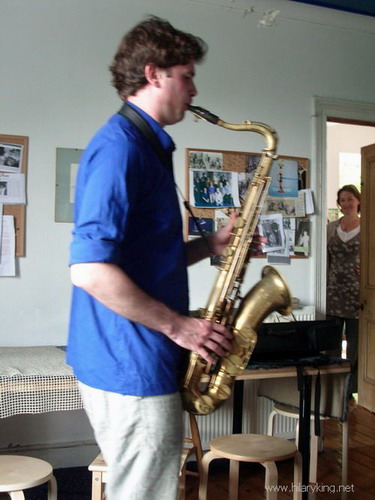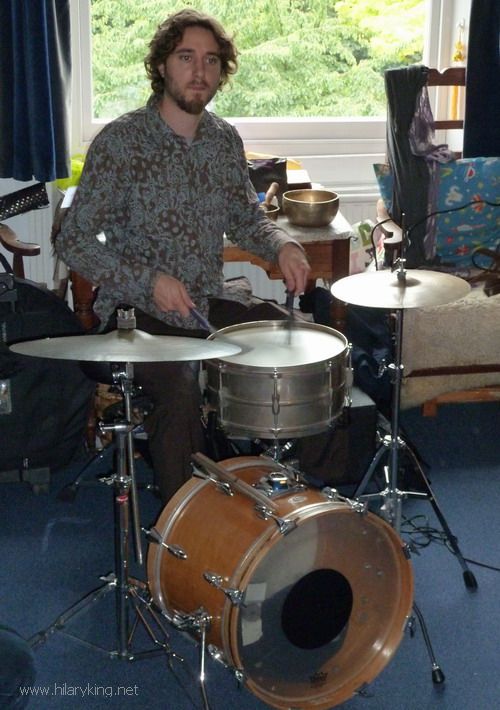‘A Modern Torture’ is how Polly Vernon describes the wearing and ‘Invasion of the Killer Heels’ in The Times Magazine on 22.10.11. It’s a excellent article to read, with graphic illustrations of famous women falling off their high heels in public.
Category Archives: Alexander Technique
More Research Into the Alexander Technique
Alexander Technique Research to Help Neck Pain
Research to Help Chronic Neck Pain
Degas and Movement
Degas and the Ballet: Picturing Movement
Alexander Technique Student Graduates as a Teacher
Tim Giles, award-winning Composer and Jazz Drummer – and now Alexander Teacher.
Tim Giles has just graduated (July 2011) from LCATT, the local Alexander Technique Teacher Training School where I am a visiting teacher. He is seen here playing at LCATT’s end of term party.Tim was one of my Alexander pupils before he joined the STAT recognised Training Course and it is great to see him qualify as an AT teacher.
I am pleased to say that Tim will be assisting me with the upcoming Short Intro Course in September – which means that participants will be able to have hands-on work both from myself and from Tim.
This introductory course is for a small group, so if you are interested in attending, please note that it is essential to enrol in advance.
Earlybird Reduced Fee is available if you pay before 30th August
Long Work Hours Increase Heart Attack Risk
Research shows that long working hours increases the risk of having a heart attack by a staggering 67%!
Now this is something that seems obvious to me as an Alexander Technique teacher but it is good to have some formal research published on the topic. There have been many occasions, unfortunately, when I have seen people overworking for long periods of time until they get really ill – in a variety of different ways it has to be said. At this point, they often have to stop work altogether for a while. But the good news is that they usually find that the Alexander Technique can be a very helpful tool to use to aid their recovery.
The lead researcher in this study of using information about working hours as a method of predicting heart attacks, Professor Kivimäki of UCL Epidemiology & Public Health, reports that people who worked more than 7-8 hours a day were 5% more likely to have a heart attack than people with a similar health background and heart risk level. Those that regularly worked 11 hours or more, increased that risk to a dramatic 67%.
Is working overtime really worth that level of risk?
The research suggests that Doctors need to include questions about work hours and lifestyle when assessing heart risk factors. It also encourages workers to look after themselves and to keep their working hours to around 7-8 hours a day.
Alexander Technique lessons can help people become more aware so they can modify the impact of overwork on their general health and wellbeing. Importantly, the Technique can help people avoid their own habits of overuse and misuse of their bodies, which can help the nervous and cardiovascular systems to calm down. As one consultant cardiologist put it:
‘The Alexander Technique is a realistic alternative to beta blockers in the control of stress-induced high blood pressure’.
Dr Bent Ostergaard – Consultant Cardiologist
Do You Slouch?
Slouching and poor posture is the topic of an article in today’s Mail Online (24 Jan 2011) in which Bella Blissett urges women not to copy the stars on the catwalk, who can be seen in various distorted postures wearing a series of excruciatingly high heels (which in themselves can cause back problems – see my article on wearing high heels).
As the ATEAM Research Trial showed, the Alexander Technique really can help people to reduce chronic back pain and to improve the quality of their life.
Please book in advance, as the workshop is for a small group.
Graduation of an Alexander Technique Student
James Allsopp’s Graduation
In July 2010, the composer and multi-instrumentalist James Allsopp,  seen here at the end of term party, graduated as an Alexander Technique teacher from the London Centre for Alexander Teaching and Training, LCATT, where I am one of the visiting teachers.
seen here at the end of term party, graduated as an Alexander Technique teacher from the London Centre for Alexander Teaching and Training, LCATT, where I am one of the visiting teachers.
James was one of my Alexander pupils before he joined LCATT on the STAT recognised 3 year Teacher Training Course. It has been a great pleasure to follow him right through to his graduation and I wish him well in the future.
GPs asked to refer patients to CNHC Practitioners
The Department of Health has requested all GPs and Chief Nursing Officers to refer patients who are seeking to use a complementary therapy such as the Alexander Technique, to practitioners who are Registered with the CNHC, The Complementary and Natural Healthcare Council.
The Society of Teachers of the Alexander Technique, STAT, has worked hard with the CNHC in order to bring about the voluntary regulation of AT teachers. The CNHC Register has been set up so that GPs and the public can see which practitioners, including myself, ‘have been assessed as meeting national standards of competence and practice’.
Hopefully, this will benefit everyone and prospective pupils can be reassured, if they need to be, that an external professional body, plus STAT, are monitoring our standards as AT teachers.
When you sit, sit; When you stand, stand
I believe this is a Zen saying and it is very pertinent to what we think about in Alexander lessons.
Many people come to me for lessons, for whom these words can bring about quite a profound realisation, as they notice the way they exist in their bodies a lot of the time.
This is particularly true for people who are very hard workers or are perhaps very stressed. They often seem to sit on the edge of the chair, ready to leap out of it at a moment’s notice, or stand with their weight mostly on the balls of their feet, as if they are about to rush away somewhere. There’s a sense that they don’t really think they should be ‘here, right now’ but ought to be doing the next thing, whatever that is.
This over-active way of being pulls us off balance, both literally and metaphorically and can contribute to aches, pains, exhaustion and a sense of being ungrounded.
However, when a pupil allows herself to ‘sit when sitting’ and to ‘stand when standing’ her weight spreads through her sitting bones or her feet in a way that allows her to feel grounded and more balanced with an easy poise, even if she is only in this position for a few seconds.
See if you can notice how you stand, try it for yourself and see if you allow yourself to be balanced easily on your feet, or do you find that there is an urgency in you that makes you want to move on all the time? This exploration would probably be easier to do in an Alexander Technique lesson, where you can have some help with becoming aware of the way you use your body. If you want to explore more, you can contact me here to set up an intro lesson.
